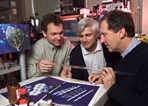Electrically powered organic laser lights the lab

By Laurie Ann Toupin
The first step in laser development is generally optical excitation, and organic lasers have been no exception. Although a number of researchers have developed optically-pumped devices, electrically-pumped versions presented challenges. Now, one can simply plug a cord into the wall to produce yellow-green output of up to 100 µW. Using tetracene as the organic material, Bertram Batlogg, Ananth Dodabalapur, Christian Kloc, and Hendrik Schon demonstrated an electrically pumped organic laser at Lucent Technology's Bell Labs in Murray Hill, New Jersey (see Figure 1).

"This is the first time this has ever been demonstrated. People get excited hearing about this electrically driven laser in contrast with optically driven ones," says Batlogg, head of Bell Labs' solid state physics research department, because of all its potential benefits. First, because this laser uses organic material as its core, it will likely be very inexpensive to produce due to ease of handling. "Organic crystals are processed at low temperatures in an easily controlled environments," says Batlogg. This contrasts sharply with the high temperatures and high vacuum environments required for inorganic lasers. "Organics of any nature, such as sugar or other hydrocarbons, don't like high temperatures. This is very desirable," he continues.
The key feature of this laser is the novel way that it can be fabricated, says Dodabalapur, device physicist for Bell Labs. For example, it could be made of flexible plastic substrate, bringing the cost of production down even further. Also a large number of these lasers could be arranged in either a linear or two-dimensional array principle, opening new possibilities for laser printing and optical storage devices. "As when the laser was first invented and the inventors had no idea of what applications would follow, we feel this would have applications that we haven't contemplated," says Dodabalapur.
Challenges
The first step in constructing the laser was finding the right organic material. "Previously, researchers in the laser community thought organic materials would never be able to carry the large current necessary for electrically powered organic lasers," says Batlogg.
"Tetracene has the advantage that it has good electrical properties. Earlier materials were mainly amorphous organic semiconductors based on small molecules as well as polymers, which have much lower charge carrier mobilities," says Schon, physicist for Bell Labs. The tetracene crystal, one of the purest organic semiconductors, remains transparent just before the intense beams of light are formed. This means that very little light is absorbed, thereby enhancing the lasing effect.
After deciding on an organic material, the researchers struggled with how to electrically pump the device while balancing the current, which includes both the negative electron and positive-hole injection, says Schon. To accomplish this, they used field-effect electrodes compared to conventional metal electrodes. The researchers prepared the field-effect transistors on both sides of the crystal, says Schon. "By using the bias of the gate we can inject either hole or electrons into the material. The electron and hole current is balanced by both gate voltages." To generate a current, the researchers apply a voltage between the two transistors. By adjusting the voltage, they can adjust the amount of electron and hole current entering the system.
"With the combined electrons and holes, we produce photons," Schon continues. The crystal and the transistor structure act as a waveguide, which serves as the confinement in that direction. The cleaved edges on the side of the crystal act as mirrors. So from this waveguide and mirror structure, the photons are amplified and the lasing occurs.
To date, the researchers produced an output of about 100 W, but they haven't measured the efficiency accurately yet, says Schon. "It is in the range of some percent. But there are additional ways that we can improve the design of the resonator so we can make the device more efficient. At the moment, it is enough prove that we can make an electrically pumped solid state laser."
Next step
Both electrical and optical design improvements need to be tackled, says Batlogg. They will begin by examining different materials in order to access more wavelengths. "We would like to cover as much of the laser spectrum as we can," says Batlogg. "Naturally we will aim for producing the blue, the green, and the red."
In addition to materials, there is the design. "We will also look at different optical cavities and other details of the design," says Batlogg. "This was just the first demonstration to show that it can be done."
This is only the latest in a long line of scientific breakthroughs that came out of Bell Labs in the field of organic materials, says Batlogg. Just this past spring they performed similar experiments using pentacene, an organic molecule with five benzene molecules.
Although an actual prototype is still a long time in the future, "this accomplishment needs to be seen in a broader context of exploring new directions in material science for electronics and photonic devices," Batlogg says. "This isn't a coincidence that this happened. We've been working on this for years. But this is an example of Bell Labs doing what it is suppose to do, to find, create, and define new directions."
About the author…
Laurie Toupin is a freelance science and technology writer based in Massachusetts.
